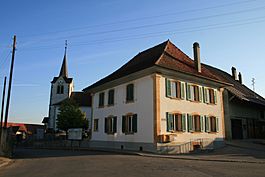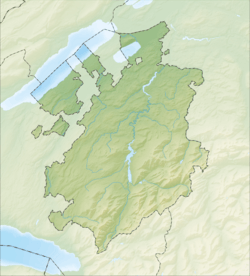Dompierre, Fribourg facts for kids
Quick facts for kids
Dompierre
|
||
|---|---|---|

Dompierre village
|
||
|
||
| Country | Switzerland | |
| Canton | Fribourg | |
| District | Broye | |
| Area | ||
| • Total | 4.5 km2 (1.7 sq mi) | |
| Elevation | 459 m (1,506 ft) | |
| Population
(Dec 2014)
|
||
| • Total | 994 | |
| • Density | 220.9/km2 (572/sq mi) | |
| Postal code |
1563
|
|
| Surrounded by | Corcelles-près-Payerne (VD), Domdidier, Missy (VD), Russy | |
Dompierre (pronounced "dom-pyair") was once a small town, or "municipality," in Switzerland. It was located in the Broye district, which is part of the Canton of Fribourg. On January 1, 2016, Dompierre joined with three other towns – Domdidier, Léchelles, and Russy – to form a new, larger municipality called Belmont-Broye. So, Dompierre is now part of this bigger community.
Contents
A Look Back in Time
Dompierre was first mentioned in old records way back in 1137. This shows that it has a very long history!
Where is Dompierre?
Dompierre is located in the Broye district of Switzerland. It sits between the towns of Avenches and Payerne. The area of Dompierre is about 4.5 square kilometers (about 1.7 square miles).
Most of this land, about 87%, is used for farming. This means there are lots of fields for growing crops. A small part, less than 1%, is covered by forests. About 10% of the land has buildings and roads. A tiny bit of land, about 1.3%, includes rivers or lakes.
What is Dompierre's Coat of Arms?
A coat of arms is like a special symbol or emblem for a town or family. Dompierre's coat of arms has a black lion standing on its hind legs. This lion has a red tongue and holds a red key. The background color of the shield is gold.
Who Lives in Dompierre?
In 2014, Dompierre had a population of 994 people. Over the ten years before that (2000-2010), the number of people living there grew by about 25%. Most of this growth was because people moved into the town.
Languages Spoken
Most people in Dompierre speak French as their main language. In 2000, about 95% of the population spoke French. A smaller number of people spoke German (about 2.4%) or Albanian (about 1.4%).
Age Groups
In 2000, about 15.7% of the population were children aged 0-9 years old. Teenagers, aged 10-19, made up about 12.6%. The largest group was adults aged 20-59. About 16% of the population was 60 years old or older.
What is Special About Dompierre?
The entire village of Dompierre is recognized as an important Swiss Heritage Site. This means it has special historical or cultural value that needs to be protected.
How Do People Make a Living?
In 2010, the unemployment rate in Dompierre was about 3.1%. This means most people who wanted to work had a job.
Jobs in Dompierre
Many people in Dompierre work in farming. This is called the "primary economic sector." Others work in the "secondary sector," which includes jobs like manufacturing and construction. The "tertiary sector" includes jobs in sales, transportation, hotels, restaurants, and education.
In 2008, there were 107 full-time jobs in Dompierre. About 36 of these jobs were in agriculture. Construction had 29 jobs, and education had 8 jobs.
Commuting to Work
Many people who live in Dompierre travel to other towns for work. In 2000, about 205 people left Dompierre for their jobs, while only 18 people came into Dompierre to work. Most people (about 65%) used a private car to get to work. A smaller number (about 7%) used public transportation.
What About Religion?
In 2000, most people in Dompierre were Roman Catholic, making up about 77% of the population. About 9.5% belonged to the Swiss Reformed Church. A small number of people were Islamic (about 4%). About 4.6% of the population did not belong to any church.
Learning and Education
In Dompierre, about 34% of the population has finished upper secondary education. This is like high school. About 4.4% have gone on to get a higher education, like from a university.
School System in Fribourg
The Canton of Fribourg has a specific school system:
- One year of optional Kindergarten.
- Six years of Primary school.
- Three years of required lower Secondary school. Students are grouped by their abilities.
- After that, students can choose to go to an optional three or four-year upper Secondary school. This can be a gymnasium (which prepares students for university) or a vocational program (which teaches job skills).
- After upper Secondary, students can go to a Tertiary school or continue an apprenticeship (learning a trade on the job).
In the 2010-2011 school year, Dompierre had 72 students in 4 classes. Many students from Dompierre also attended schools in nearby towns.





